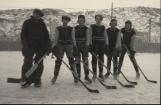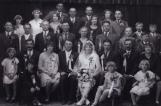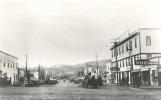1
Panoramic view of early mine camp. Two headframes in background.20th Century
Drumheller, Alberta
 Credits:
Credits:Atlas Coal Mine Historical Society
2
The towns in and around Drumheller were growing and populated almost entirely by immigrants. British and Eastern European men flocked to the valley looking for work. Once they found it, they often made a home for themselves and their families. As communities emerged, sports, arts, culture, and social events began drawing people together. Over time as these differing ethnic groups sank roots into the soil, people came together to create a sense of community and family regardless of background, race, or politics.5
As the valleys population grew, so did opportunities for entertainment. There were operas, live theatre and even picure shows. Although live theatre often drew the largest audience, movie theatres such as The Napier, were open for business and gaining in popularity daily."From the first, the place was not without its social and religious life. It was like one big family, and there was always some talent among the crowd. There was a foreign chap who would delight everyone with his whistling. There were several English boys who loved to sing. Rev. John Brown used to come down on Sundays, and everybody gathered in the dining room, or in front of the office in the summer, and sang the old hymns. One young fellow I remember, loved to sing. He had lived a tough life and seemed to be a tough fellow in some ways, but when he started to sing hymns he seemed to forget himself, and he used to pick out some which he said were favourites of his mother. Also, there was a violinist who had been a concert violinist before drink had ruined him, and he could loose himself in his music. A little later, Mr. Moodie brought and old organ out, and no one could play it, but there was a little girl that used to pick out the tune with one finger, and everybody sang as if it were a pipe organ."
- Mrs. Annetta E. Roper - Wife of George Roper, an employee of J.F. Moodie who owned one of the very first mines in the Valley. "The Early Days of Rosedale." Letter written in 1918 and submitted to the Rosedale Women's Institute.
7
Boys hockey team East Coulee; l-r: Don Campbell,Bill Woods,George James, Babe Myers and Julius Bodar20th Century
East Coulee, Alberta
 Credits:
Credits:Atlas Coal Mine Historical Society
8
Having a population that was male dominated, meant the popularity of organized sports grew as quickly as the town itself. There was hockey, bocce ball, baseball, football, and curling to name a few. These organized sports games became a community event, as onlookers cheered for their favourite team. Mine operators often took a leading role in the sports community, by supporting teams and hosting events. Although heavily populated with men, the valley ladies also took part in organized sports such as hockey, baseball and curling.9
Four members of the miners baseball team1925
Drumheller, Alberta
 Credits:
Credits:Atlas Coal Mine Historical Society
10
Community events also brought people together on a regular basis. Each community had their own hall for social events. Dances were held? in some cases weekly? and locals in the valley would gather together to bust loose.11
Photo of John and Mary Bozowski's wedding3 November 1929
 Credits:
Credits:Atlas Coal Mine Historical Society


